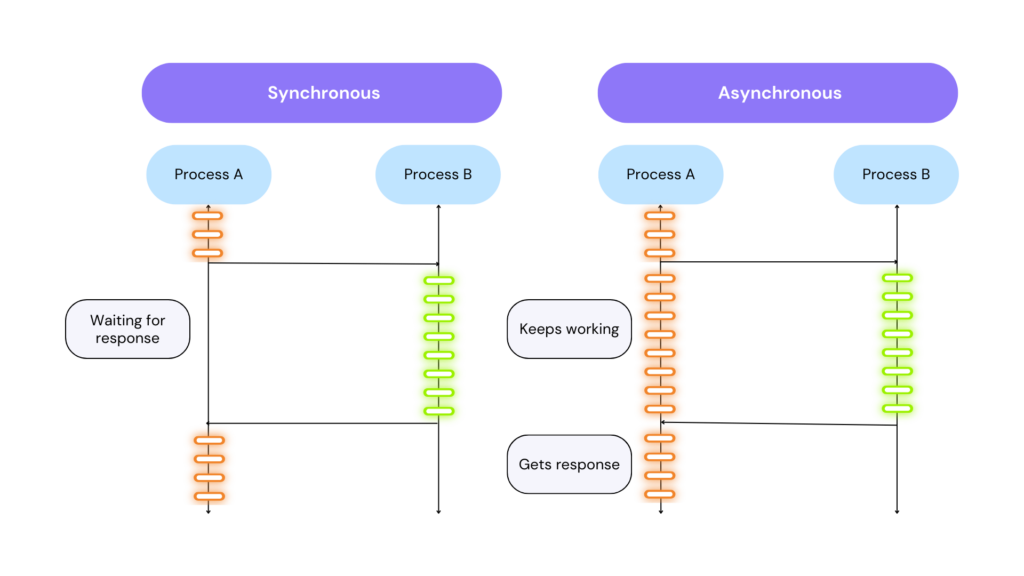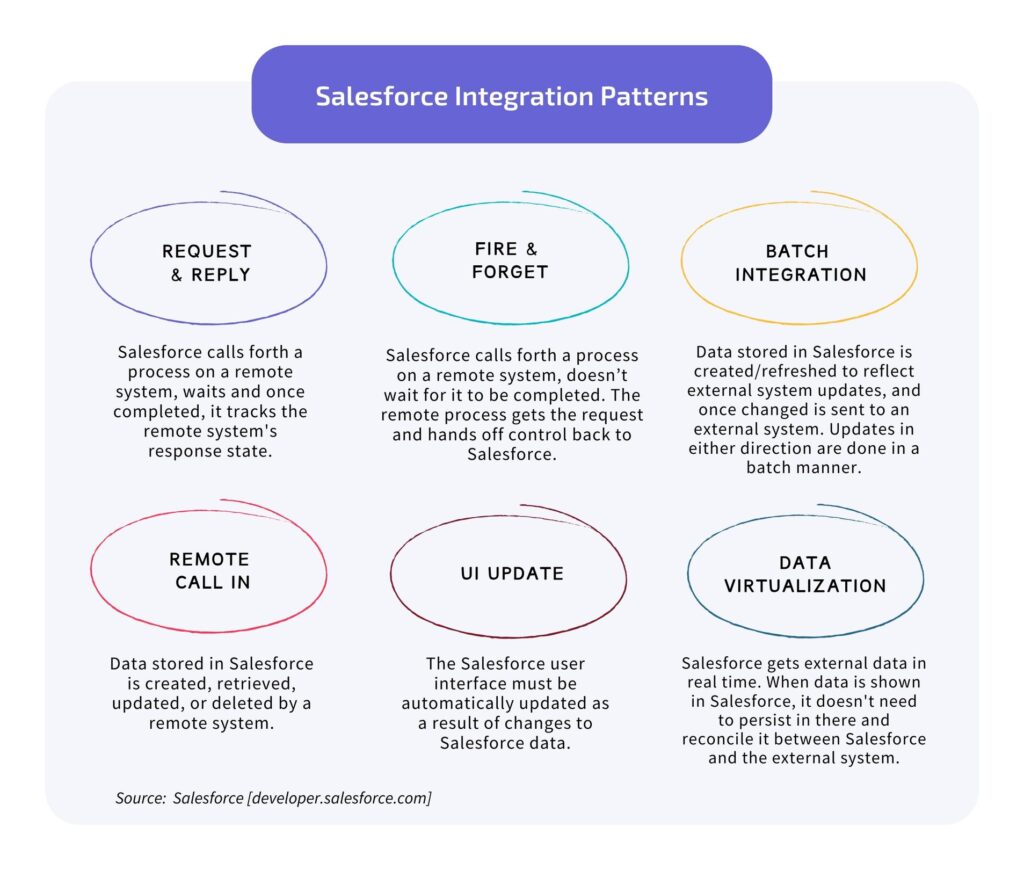What can we do to avoid a Salesforce integration failure?
THIS is the problem behind this article.
A lot of investment goes into a system integration, such as money, time, planning, and strong expectations. Salesforce has over 2,500 integrations and applications available to make your life (or your customer’s life) easier. So why not take advantage of it in the best way possible?
In this article, you will learn how to manage your integration in the best way possible by handling all major factors and acknowledging the Want to avoid a Salesforce integration failure? We will show you how to manage all factors behind Salesforce Integrations Best Practices.

Basics
First, let’s go back to basics. What is an integration?
A Salesforce integration happens when two or more systems come together through a process that facilitates functions or procedures that were once separate. By doing so, all their data is easier to handle by means of multiple, now connected, processes and systems running hand in hand.
Think about it for a second. It’s quite weird to find a system nowadays that is fully isolated.
Dealing with integrations is an essential part of a Salesforce technologist’s job. Hence, becoming skilled in this process means performing the integration faster, with little to no errors, while recognizing that the systems should stay malleable and accessible to other future integrations.
Did you know?
An essential part of any integration is the famous API, an Application Programming Interface. The API is essential because it works as a software intermediary between the applications to communicate with each other.
Without it, there would be no interaction and integration between the systems.
In order to build a good integration and have it perform to the best of its ability, you need to consider all the factors that affect its proper functioning. There are many, but for this example, we will highlight timing. To put it simply, be certain that your processes run to a suitable clock. Whether you choose a synchronous or asynchronous one, would depend mainly on the integration type.
And to help you remember how they work here is a graphic to keep handy…

Security Comes First
As it should be, security is one of the most important factors when it comes to Salesforce integrations. Plenty of factors affect security, but what matters most is taking care of what may have undue access or even harm your integration pattern, your data, as well as your customer’s data. Security elements that typically manage firewalls, forward proxy, reverse proxy, encryptions, and the WS protocol, prevent your system from being invaded by harmful disruptions in the following ways:
- Countering attacks
- Managing your sensitive information
- Protecting your online identity
- Handling authentications
- Throttling
Even with all their help, security measures are still number one in our list of best practices and should be counted as primary for each individual project. Brushing them aside as a routine step should be avoided at any cost. For more information, consult security considerations.
Salesforce Integration Patterns
Salesforce patterns and the requirements behind your project, go hand-in-hand. Therefore, patterns need to be carefully understood to handle them better. Makes sense, right?
Before going ahead, think about timing, direction, security measures, and anything else that impacts their correct functioning. To learn more about patterns, their type, timing, and patterns to consider, consult the Salesforce Pattern Selection Guide.

Now that you have a better understanding of what patterns are, let’s go over some simple factors and the questions affecting each.
- Since Salesforce needs to perform processes based on the response it receives, the first factor to consider is keeping track of transactions being followed.
- Timing, as mentioned previously, is also an important factor. Check if it should be synchronous vs asynchronous. Do the processes need to be in real-time vs near real-time?
- Ultimately, there are a few other elements to manage, such as integrating declaratively or not, the size of your message, how to protect against unforeseen situations (ex. your external system going down), and all matters related to the Salesforce contract.
The platform being used can also be a factor that alters patterns and integrations. We recommend using MuleSoft. You can design, build, customize, and integrate your APIs faster thanks to its one-in-all platform that also allows testing, grants you pre-build assets, and lets you discover more APIs to expand your reach. There are other resources like Informatica and Jitter that should also work nicely. However, MuleSoft is a formidable contender in terms of data management, customization, and customer experience. You won’t be disappointed.
Common Mistakes
From not handling the scope of your project, to losing sight of all the requirements – it’s human to miss the beat and lose track of what is really at stake. Keeping track of things can save you time, money, and stress. We know you know this, but it’s never a bad idea to have some useful reminders.
Here you’ll find some tips to make your life easier and avoid common yet foreseeable mistakes…
Check your to-do list.
- Before getting started, be mindful of activating and deactivating the corresponding components. Improper activation may disturb both your implementation and your team’s workflow.
- Pay attention to workflows, triggers, as well as conflicts and discrepancies with mapping data fields, types, and structures.
- Be careful not to duplicate worthless data. Do the dishes! Have everything neat and ready before and after integrating your systems.
- Choose the right system architecture. Take your time to select the right system since it is a crucial decision that may cost you more in the long run.
- Check if you need to consider any future customizations that will influence key decisions, such as the integration type, pattern, security measures, and others specific to your implementation.
Don’t lose track of things.
- This may sound obvious, but having a clear idea of what you’re about to implement will always be the first step to take into account.
- Be mindful of objectives and priorities that may save you from having to go back and start over from scratch.
- We recommend asking for help from a consultant if necessary. Help is never a bad idea.
- Whoever is responsible for implementing the integration needs to be mindful of every activity, commit, and comma – in order to avoid serious problems in the long run.
- Whenever there is a need to change or customize your work, be sure to keep things in order and your documentation will become a lifesaver.
- Keep in mind that Rome wasn’t built in a day. Your integration will go through phases that can be thwarted by early avoidable mistakes.
Summary
After understanding the importance of what an integration really is, and the role of the API behind it, we know that security comes first. The security elements that typically manage tools like firewalls and proxies have a crucial role to play and shouldn’t be left aside.
Choosing the right pattern, architecture, and platform is also important. They all influence each other. Any integration is different in itself and should be respected as such.
Finally, remember that checking your to-do list and keeping track of things will save you lots of headaches down the road. Try to maintain everything as neat and sorted as you can, from activating and deactivating components, to managing documentation and your integration’s lifecycle.
At Oktana, we’re both Salesforce and MuleSoft partners, skilled at Salesforce integrations, including Heroku and Slack. With certifications across a wide range of Salesforce products, in addition to products like Informatica and MuleSoft, we can connect any app or system to the Salesforce ecosystem.
If you’re in need of a consultant to help expand your current resources and augment your team, don’t hesitate to contact us. Our team of Salesforce experts is here to help support your project.






